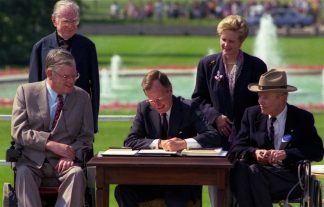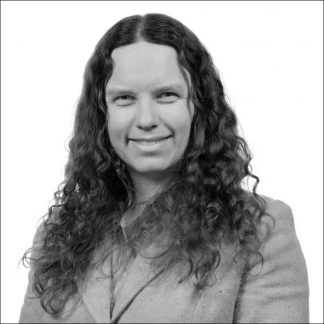By Allison Campbell-Jensen

President George H. W. Bush Signs the Americans with Disabilities Act, July 26, 1990. Courtesy, National Archives.
Thirty-two years ago the Americans with Disabilities Act was signed into law, but many of its legal requirements to provide reasonable accommodations did not immediately take effect.
So in 1991, when American Libraries published an article, “What every librarian should know about the Americans with Disabilities Act”[1], writer Michael G. Gunde issued this warning: Libraries would most likely continue to omit to provide full accommodations for all their patrons who need them.
His words, in many ways, were telling — especially when looking back at the digital transformation of information.
“I don’t want to undersell how important or impactful the ADA was — it was landmark legislation. At the same time, that was 30 years ago,” says Phil Dudas, co-chair of the University of Minnesota’s Libraries Accessibility Steering Committee, or LASC. “It has taken us decades to get to the point that it has some teeth and even trickled down to the digital world. We are still implementing it, in many ways.”
Raising awareness; changing culture
The Libraries Web Content Management Committee, which Dudas co-leads along with Web Development staff, works on the accessibility of the Libraries website, among other things.
But the primary responsibility for accessibility, he says, often lies with subject matter experts or with those producing tools — like the alt-text team for the Webb telescope images (see sidebar), which spent a few weeks experimenting with language to land on the tone and the content that they sought to convey.
Raising awareness, providing education, and connecting to the Libraries subject experts is what LASC has done since it was formed in 2018. Its goal is to increase the Libraries’ responsiveness to accessibility needs.
The committee, for example, has:
- Conducted research to determine the Libraries’ accessibility strengths and areas where improvement is needed.
- Developed an online professional development course, the Accessibility Fundamentals Pathway.
- Provided training resources for library supervisors.
- Participated in the multi-consortial Library Accessibility Alliance of more than 100 academic libraries, and
- Promoted Global Accessibility Awareness Day to all U of M faculty, students, and staff.
Amy Drayer, LASC co-chair, sees these activities as encouraging a cultural shift. It’s realized in “the way that people are now thinking about it [accessibility] in their work, where things can change, and thinking about people with disabilities up front — and not necessarily scrambling at the end” of a project.
That said, LASC members eagerly work with anyone who asks for help, as well as fielding requests forwarded from the U’s Disability Resource Center. In many cases, the committee members may not know the name of the person making the request for a change or another accommodation.
One student, who transferred to the Twin Cities campus last year from Duluth, asked about a room set aside for people like herself who are sensitive to stimuli. There wasn’t one, so Libraries’ staffer Richmond Kinney, with the student’s help, set up a Sensory Friendly room on the basement level of Wilson Library to meet this need.
Those who request the key do not need to describe any disability: the room is open to all users.
Inclusion means more than eliminating exclusion
“We’re not interested so much in the compliance component as we are in creating a sense of belonging.”
—Amy Drayer
Helping those with disabilities, bringing down barriers, and making the Libraries’ books, journals, and other resources accessible are keys to ADA compliance. Still, there’s more beyond simply following a set or rules or rulings, says Drayer.
“We’re not interested so much in the compliance component as we are in creating a sense of belonging,” she says. President Gabel’s administration recognized that students’ mental health, already a concern, became an even more widespread issue during the time of dealing with COVID, Drayer notes. The efforts to meet students where they are with such “invisible” disabilities, by setting up a mental health clinic in Wilson Library and promoting self-care for students, are steps in the right direction.
For the 600,000 people in Minnesota with one or more functional disabilities, and the 15% of the global population, this commitment to serve anyone with any disability — and so serve individuals of any ability — is good news.
The importance of alt text
The Webb telescope has opened up wonders of the universe for all of us — including those with vision issues. One of the pleasant surprises about the release of these WOW! images was their inclusion of alt text — vivid descriptions of the images for those who are blind or have low vision. As reported in the Washington Post, people who need alt text were deeply touched.
“‘As a blind person who has had dreams of doing astronomy since I was 6 … thank you to whoever not only remembered to write alt text for this — but did so in such a beautiful way,’ software developer and accessibility activist Katie Durden wrote on Twitter. ‘I’ll likely never know who you are. But you touched my heart this day, alt-text writer.’”
The team who wrote the alt-text copy, from the Space Telescope Science Institute in Baltimore, was happy to hear positive reactions from her and many others. The descriptions “can be appreciated by someone who is blind or someone who wants to know more about astronomy or anyone who appreciates the care that goes into choosing just the right word,” Theresa Vargas reported (italics hers).[2]
Anyone in 1990 who predicted that images from the beginning of time would be described to make it easier for those with vision issues to “see” the cliffs, stars, and galaxies of deep space would have been a true visionary.
[1] Gunde, Michael G. “What Every Librarian Should Know about the Americans with Disabilities Act.” American Libraries, vol. 22, no. 8, 1991, pp. 806–09. JSTOR, http://www.jstor.org/stable/25632347. Accessed 25 Jul. 2022.
[2] Vargas, Theresa. “The unexpected star of NASA’s Webb images — the alt text.” The Washington Post, posted online July 20, 2022.






